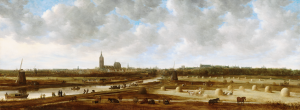Glitter and glamour in the Middle Ages
Philip the Good had the Great Hall richly decorated with beautiful carpets and expensive works of art that travelled along with the Duke. The guests and the Golden Fleece knights stayed around the Inner Courtyard. Beds and other utensils were borrowed from neighbouring residencies. And when the Golden Fleece knights left the Inner Courtyard with their horses to go to the Great Church, they went with great pomp and circumstance: a huge parade of banners, trumpeters, bell chiming, decked out horses, and knights dressed in the most splendid gowns and jewellery.
Did you know:
that the Burgundy court was known for its rich court culture? For example, Jan van Eyck was among Philip the Good’s court artists.
In this type of parade, the nobles were followed by an entourage of footmen.
In their retinue were the households of the nobles: the more extensive and the richer adorned, the more prestige the monarch had. The spectacle would be lustred by court fools and musicians playing wind instruments like trumpets, pipe flutes and shawms. The embroidered and painted coats of arms of the Golden Fleece knights on the horse cloths, banners, pennants and trumpet flags showed who the people in Holland were dealing with.
Did you know:
that in the Great Hall, today known as the Knights’ Hall, were famous and impressive carpets that together measured over 100 metres long?
The Golden Fleece knights themselves wore red, long, wide coats, with gold-thread embroidered edges during the Chapter. This was the typical dress for a Golden Fleece knight, also called robes. With it came a hat, called a chaperon, and, of course, the Golden Fleece chain. Knights were to wear the Golden Fleece at all times.
The Chapter was such an extraordinary event that spectators travelled from France, England, Spain, Italy and Germany to what was otherwise the sleepy town of The Hague to witness the festivities. Philip the Good had good reason to save no trouble or expense for the Chapter. Rumour had it that the monarch did not have the money to go to war against Utrecht to decide the bishop issue. To prove everybody wrong, the Duke wanted to make an overwhelming impression, both in The Hague and all over County Holland.

